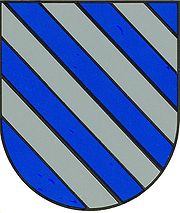
Count of Atouguia
Encyclopedia

Count
A count or countess is an aristocratic nobleman in European countries. The word count came into English from the French comte, itself from Latin comes—in its accusative comitem—meaning "companion", and later "companion of the emperor, delegate of the emperor". The adjective form of the word is...
of Atouguia
Atouguia da Baleia
Atouguia da Baleia is a parish in the municipality of Peniche, in Portugal, with an area of 46.04 km² and a population of 7,988 residents .The village of Atouguia da Baleia has almost 2,000 residents...
(in Portuguese Conde de Atouguia) was a Portuguese title of nobility created by a royal decree, dated from 17 December 1448, by King Afonso V of Portugal
Afonso V of Portugal
Afonso V KG , called the African , was the twelfth King of Portugal and the Algarves. His sobriquet refers to his conquests in Northern Africa.-Early life:...
, and granted to D. Álvaro Gonçalves de Ataíde.
This title was extincted due to the 11th Count involvement in the Távora affair
Távora affair
The Távora affair was a political scandal of the 18th century Portuguese court. The events triggered by the attempted murder of King Joseph I of Portugal in 1758 ended with the public execution of the entire Távora family and its closest relatives in 1759...
. The plot was discovered, the count was executed and his House and estates were confiscated.
List of the Counts of Atouguia (1448)
- D. Álvaro Gonçalves de Ataíde (c.1390-1452);
- D. Martinho de Ataíde (c.1410- ? ), his son;
- D. Luis de Ataíde (1517-1580), his great-grandson, 10th ViceroyViceroyA viceroy is a royal official who runs a country, colony, or province in the name of and as representative of the monarch. The term derives from the Latin prefix vice-, meaning "in the place of" and the French word roi, meaning king. A viceroy's province or larger territory is called a viceroyalty...
of IndiaPortuguese IndiaThe Portuguese Viceroyalty of India , later the Portuguese State of India , was the aggregate of Portugal's colonial holdings in India.The government started in 1505, six years after the discovery of a sea route to India by Vasco da Gama, with the nomination of the first Viceroy Francisco de...
; - D. João Gonçalves de Ataíde (c.1560- ? ), his 2nd cousin;
- D. Luís de Ataíde (c.1570- ? ), his son;
- D. Jerónimo de Ataíde (c.1610-1665), his son;
- D. Manuel Luís de Ataíde (c.1640- ? ), his older son;
- D. Luís Peregrino de Ataíde (c.1662-1689), his younger brother;
- D. Jerónimo de Ataíde (c.1680-1720), his son;
- D. Luís Peregrino de Ataíde (1700- ? ), his son, 6th ViceroyViceroyA viceroy is a royal official who runs a country, colony, or province in the name of and as representative of the monarch. The term derives from the Latin prefix vice-, meaning "in the place of" and the French word roi, meaning king. A viceroy's province or larger territory is called a viceroyalty...
of BrazilBrazilBrazil , officially the Federative Republic of Brazil , is the largest country in South America. It is the world's fifth largest country, both by geographical area and by population with over 192 million people...
; - D. Jerónimo de Ataíde (1721-1759), his son.

